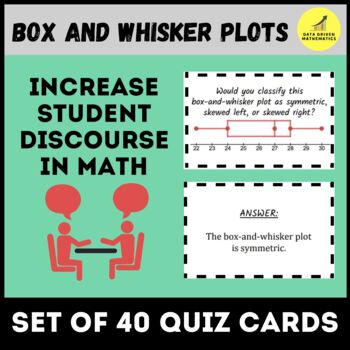Box and Whisker Plot - Quiz Cards Activity
- Zip
Description
About This Resource:
This is a set of 40 Quiz Cards focusing on box-and-whisker plots. These are created so students can practice their mental math skills. There are several different activities you can do in your classroom using Quiz Cards and these cards will work for each activity.
What's Included:
You will receive a zipped folder containing...
- Quiz cards in PDF format. These cards are easy to assemble. Print the cards double sided on printer paper or cardstock. Cut the cards along the lines and the questions will be on the front and the answer on the back!
- BONUS file with instructions on how to get any item for FREE in our TPT Marketplace. *Bundles not included
Activities to use with Quiz Cards:
Activity #1 - Quiz Each Other
Each student gets their own Quiz Card. Use a method for students to interact with each other. This could be mingling around the classroom, using an inside and outside circle, or some other student interaction model. Students take turns quizzing each other with their cards and then exchange cards at the end before moving on to a new partner.
Activity #2 - Team Quizzing Game
Provide a set of all 40 Quiz Cards to each group of students. It works best in groups of 3-4 students. One student fans the cards to another student who picks one from the deck. This student then reads and shows the question to a third member who attempts to answer the question. Rotate cards.
Similar Products You May Be Interested In:
Google Forms Quiz - Dot Plots, Histograms, and Box Plots - 6.SP.4
Comparing and Interpreting Dot Plots, Box-and-Whisker Plots, and Histograms
One Variable Statistics Quiz 2 (Box-and-Whisker Plots, IQR, and Outliers)
Constructing Box-and-Whisker Plots Stations Activity
Box-and-Whisker Plot Investigation and Notes
Become the first to know about my freebies, sales, and new products!
Look for the green star near the top of any page within my store and click it to become a follower. You will then receive customized email updates about my store, including new products which are 50% for the first week. Please follow!
I am here to support you the best I can. Please feel free to contact me at any time. I try to respond to all emails within 48 hours.
Credits: Clipart in cover photo by: studiog on Canva.


